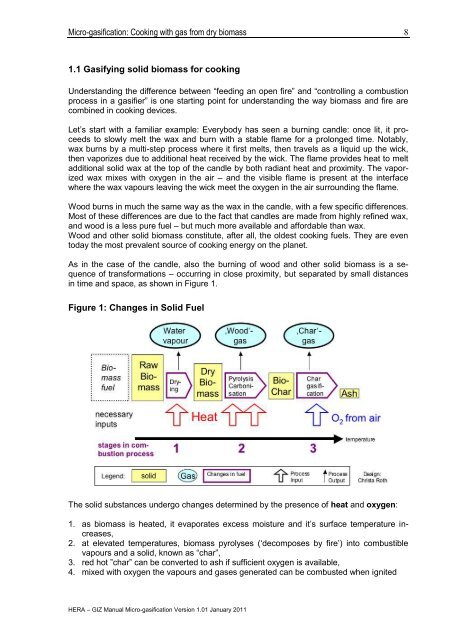Micro-gasification: Cooking with gas from biomass - Amper
Micro-gasification: Cooking with gas from biomass - Amper
Micro-gasification: Cooking with gas from biomass - Amper
Create successful ePaper yourself
Turn your PDF publications into a flip-book with our unique Google optimized e-Paper software.
<strong>Micro</strong>-<strong><strong>gas</strong>ification</strong>: <strong>Cooking</strong> <strong>with</strong> <strong>gas</strong> <strong>from</strong> dry <strong>biomass</strong><br />
1.1 Gasifying solid <strong>biomass</strong> for cooking<br />
Understanding the difference between ―feeding an open fire‖ and ―controlling a combustion<br />
process in a <strong>gas</strong>ifier‖ is one starting point for understanding the way <strong>biomass</strong> and fire are<br />
combined in cooking devices.<br />
Let‘s start <strong>with</strong> a familiar example: Everybody has seen a burning candle: once lit, it proceeds<br />
to slowly melt the wax and burn <strong>with</strong> a stable flame for a prolonged time. Notably,<br />
wax burns by a multi-step process where it first melts, then travels as a liquid up the wick,<br />
then vaporizes due to additional heat received by the wick. The flame provides heat to melt<br />
additional solid wax at the top of the candle by both radiant heat and proximity. The vaporized<br />
wax mixes <strong>with</strong> oxygen in the air – and the visible flame is present at the interface<br />
where the wax vapours leaving the wick meet the oxygen in the air surrounding the flame.<br />
Wood burns in much the same way as the wax in the candle, <strong>with</strong> a few specific differences.<br />
Most of these differences are due to the fact that candles are made <strong>from</strong> highly refined wax,<br />
and wood is a less pure fuel – but much more available and affordable than wax.<br />
Wood and other solid <strong>biomass</strong> constitute, after all, the oldest cooking fuels. They are even<br />
today the most prevalent source of cooking energy on the planet.<br />
As in the case of the candle, also the burning of wood and other solid <strong>biomass</strong> is a sequence<br />
of transformations – occurring in close proximity, but separated by small distances<br />
in time and space, as shown in Figure 1.<br />
Figure 1: Changes in Solid Fuel<br />
The solid substances undergo changes determined by the presence of heat and oxygen:<br />
1. as <strong>biomass</strong> is heated, it evaporates excess moisture and it‘s surface temperature increases,<br />
2. at elevated temperatures, <strong>biomass</strong> pyrolyses (‗decomposes by fire‘) into combustible<br />
vapours and a solid, known as ―char‖,<br />
3. red hot ‖char‖ can be converted to ash if sufficient oxygen is available,<br />
4. mixed <strong>with</strong> oxygen the vapours and <strong>gas</strong>es generated can be combusted when ignited<br />
HERA – GIZ Manual <strong>Micro</strong>-<strong><strong>gas</strong>ification</strong> Version 1.01 January 2011<br />
8
















